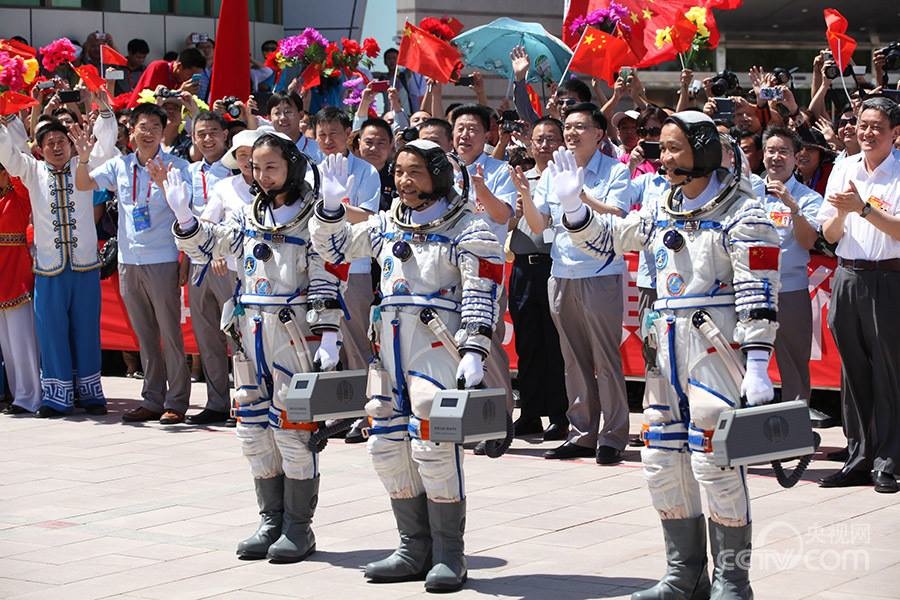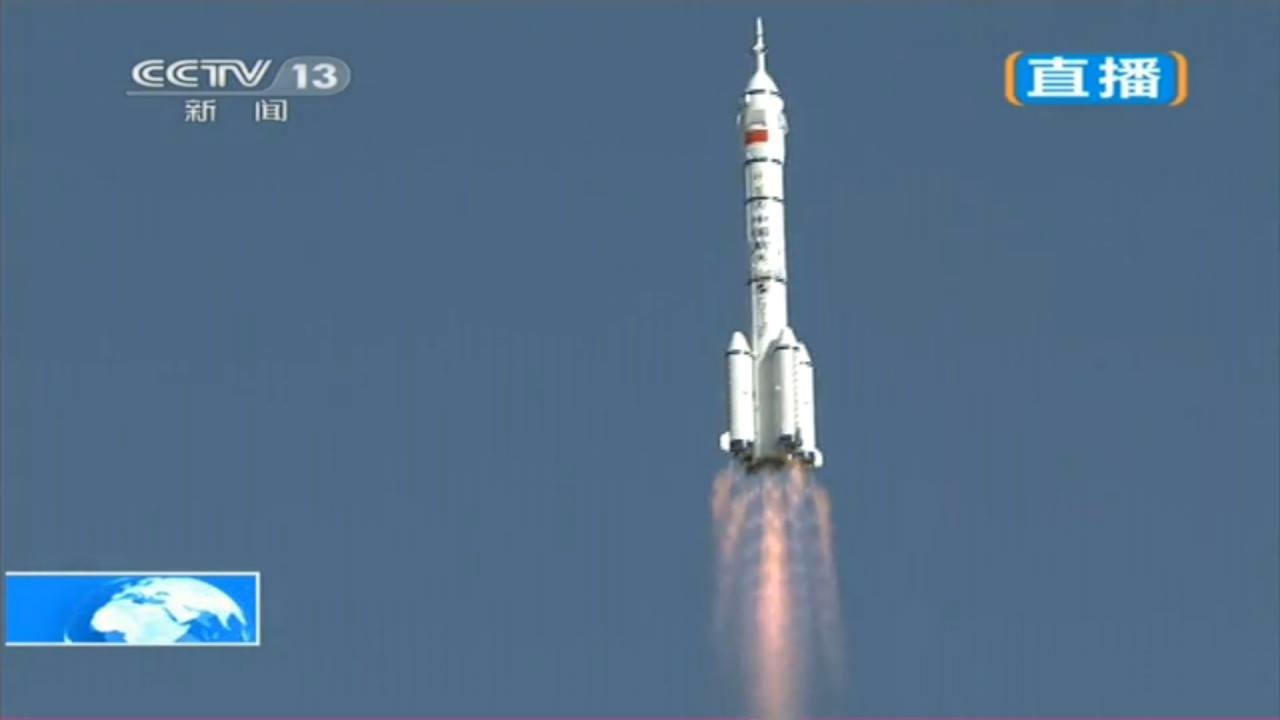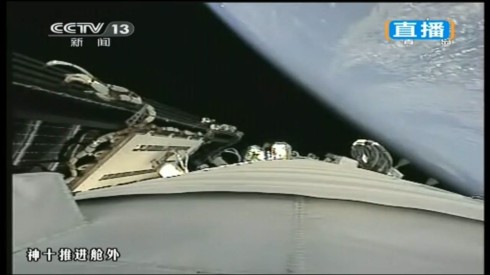Shenzhou 10: another step in China’s ‘Long March’ into space


The colorful and polished launch of Shenzhou 10 confirms that China has come of age as a spacefaring nation. At 19:40 AEST on Tuesday June 11 (17:40 local time) three ‘yuhangyuan’, Chinese astronauts, embarked on China’s sixth crewed space mission. This second mission to Tiangong 1, the Chinese space station, is a credible step in mastering the art and engineering of space exploration. It was also a public relations success.
Shenzhou 10 crew
Announcing in early April, that Wang Yaping, a 33 year old Major in the PLA Air Force, was one of the 3-person Shenzhou 10 crew, silence then descended on the identity of the other crew members. Wang was named as the in-flight instructor. She becomes China’s second female and 9th astronaut to have flown. As the in-flight instructor Wang will give lectures to middle and elementary school students from orbit.
Building the suspense the Chinese finally announcing the other two the names of the three person crew yesterday. Along with Wang the Shenzhou 10 crew are: Nie Haisheng (48) Commander of Shenzhou 10, a veteran of Shenzhou 6 in 2005, and a Major General in PLA Air Force, and Zhang Xiaoguang, 47 Assistant Pilot of Shenzhou 10, backup crew of Shenzhou 9 (along with Wang) and a Senior Colonel of PLA Air Force.
This places the Chinese astronaut corps as a modern, relatively, gender balanced operation. Zhang and Nie both hale from the 1996 second astronaut selection. As have all male yuhangyuan to date including Yang Liwei, China’s first astronaut. The first group of astronauts were selected in 1971 in a hopelessly ambitious and quickly abandoned attempt to put astronauts into space in the 1970s. Wang, along with Liu Yang, China’s first female yuhangyuan, comes from China’s 2010 third group of yuhangyuan. The Chinese, at least to the outside world, have not followed the more memorable and colorful NASA lead of allowing astronaut groups to pick their nick-names.
The heavenly palace
With the launch a success, Nie will now chase, rendezvous and dock with an orbital laboratory, Tiangong (a mandarin word meaning “heavenly palace”), which was launched nearly two years ago on September 29, 2011.On November 2, 2011 China successfully docked the unmanned Shenzhou 8 with Tiangong. It remained docked for 14 days and then undocked and repeated the docking maneuver – proof that the first was not a fluke. It then was undocked, leaving Tiangong to its solitary orbit 370km above the earth’s surface.

On June 18, 2012 a second craft docked with Tiangong. This time it was the crewed Shenzhou 9. The space station was then declared operational. China had joined Russia and the USA in having the capability to become space residents. The three person crew on Tiangong conducted experiments and aclimatised to the prolonged weightlessness for their 10 day mission.
The normal pattern was for two to sleep in Tiangong and one to sleep in Shenzhou. At only 10.4m in length, Shenzhou is smaller than the 1971 Russian Salyut (13.1m) and the 1973 US Skylab (36.1m) space laboratories. Like these other first space laboratories Tiangong is designed with a limited lifespan. The current mission, Shenzhou 10, will be the last to Tiangong 1.
Shenzhou 10
As is the norm now the Shenzhou launch was covered live by the Chinese media. providing pictures, expert commentary and graphics depicting what was going on at the various stages of the launch. Shenzhou 10 is now safely in orbit and will spend the next few days approaching a suitable orbit for docking. The Shenzhou 10 will dock with the orbiting lab module Tiangong 1 several times.
“The three astronauts will stay in orbit for 15 days, including 12 days when they will work inside the coupled complex of the Shenzhou 10 and Tiangong 1,” said Zhou Jianping, head designer of China’s manned space program. It is expected that they will set a Chinese record for time in orbit.
The interesting point is that the mission profile for Shenzhou 10 is opaque. Although it is expected that the craft will be put through it’s docking paces – not something to be dismissed lightly – the scientific and engineering goals of this mission are less obvious that the recent Shenzhou missions.

This will be the last Chinese human space mission for quite some time. The next Shenzhou missions are expected to fly to the Tiangong 2 laboratory. This will be an expanded version of Tiangong 1, similar in design to the Russian 1986 Mir space station. It is expected to be able to sustain 20-day visits. It will probably not be launched until around 2015 or possibly later. The gap between the flight of Shenzhou 10 and Shenzhou 11 could ultimately prove to be the longest hiatus in Chinese human spaceflight to date.
Regional implications
With this in mind it will be interesting to see how the Chinese promote this current mission once it is completed. Its success, or otherwise, will not aid any military space activities, nor directly any commercial space activities. It does provide a compelling message, I suggest, to its regional competitors. Human exploration is possibly the most expensive and prestigious space activity. I think we will find China promoting this expedition to its fullest, as it build on its robotic missions to the Moon over the next few years. Fully intending to continue its long march to put humans onto the moon and mars in the next few decades.
Orrman-Rossiter K (2013-06-12 05:07:52). Shenzhou 10: another step in China's 'Long March' into space. Australian Science. Retrieved: Jul 19, 2025, from http://ozscience.com/space/shenzhou-10-another-step-in-chinas-long-march-into-space/
 Follow
Follow
It may seem a little amateurish – it is however China’s first ever lecture from space. Presented live from Tiangong 1 the astronauts from Shenzhou 10 do a fantastic job.